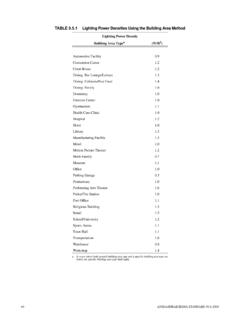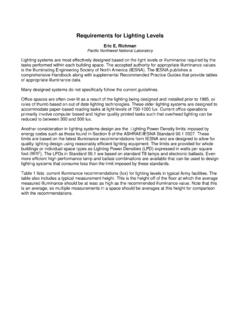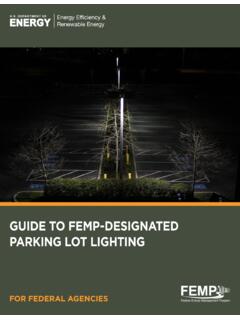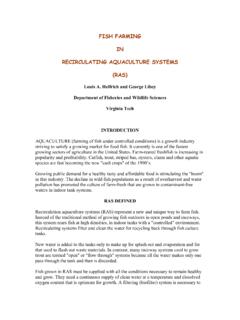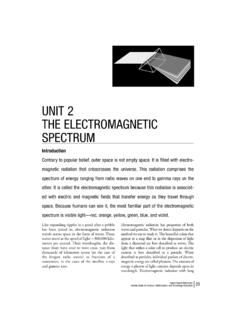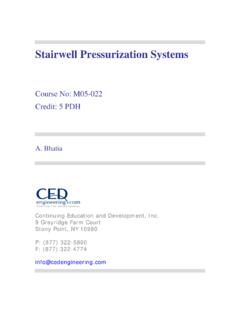Transcription of Parking Structure Lighting Guide - Energy
1 TABLE OF CONTENTS. 1 INTRODUCTION. FEMP-DESIGNATED PRODUCTS. Energy EFFICIENCY METRICS. 3 DESIGN PROCESS. STEP-BY-STEP OVERVIEW. 6 COMPONENTS OF THE DESIGN. BUILDING DESIGN CONSIDERATIONS. MATERIAL SELECTION. Lighting DESIGN CONSIDERATIONS. LUMINAIRE DISTRIBUTION. COLOR QUALITIES. LUMINAIRE LAYOUT. 13 Parking Structure Lighting DESIGN. DESIGN SCENARIO OVERVIEW. DESIGN SCENARIO GENERAL LUMINAIRE. DESIGN SCENARIO FEMP-DESIGNATED LUMINAIRE. 17 Lighting CONTROLS SAVE Energy . PHOTOSENSORS. OCCUPANCY SENSORS. 20 COST-EFFECTIVENESS. 21 RESOURCES. National Renewable Energy Laboratory's Parking Structure utilizes many measures to achieve a Parking Structure that uses 90% less Energy than the baseline Energy code.
2 Parking Structure Lighting Guide 1. INTRODUCTION. Legislation and the Federal Acquisition Regulations (FAR) require federal agencies to specify and buy Energy STAR qualified products or, in categories not included in the Energy STAR program, products that meet or exceed efficiency requirements designated by the Federal Energy Management Program (FEMP). Agencies that follow requirements to buy efficient products can realize substantial operating cost savings and reduce pollution. As the world's largest consumer, the federal government can lead the entire market achieve greater Energy efficiency while saving taxpayer dollars.
3 FEMP provides acquisition guidance and federal efficiency requirements across a variety of product cate- gories, including Parking garage luminaires, which are a FEMP-designated product category. Federal laws and executive orders mandate that agencies meet these efficiency requirements in all procurement and acquisition actions that are not specifically exempted by law. The purpose of this Guide is to explain in greater detail the FEMP-designated Parking garage/ Structure product category, to show how the equipment can be used to maximize total Energy efficiency (using the metrics defined below), and to provide an estimate of the cost effectiveness using FEMP-designated products.
4 Energy EFFICIENCY METRICS. There are different Energy efficiency metrics. Although there are several metrics to describe Energy efficiency, here we consider three Lighting -specific metrics: efficiency (very simple), efficacy (simple), and Lighting power density (complex). This Guide primarily focuses on efficacy, and demonstrates how efficacy incorporated with other elements can reduce power densities. Efficiency Efficiency is a measure of how effectively a device converts input into output. Luminaire efficiency (LE) is the light leaving the luminaire divided by the light generated by the bare lamp (light bulb) when operated outside of the luminaire.
5 Because both values (the light leaving the luminaire and the light generated by the light source[s]) have the same unit, luminaire efficiency is therefore a unitless ratio. Efficacy Efficacy is the capacity to produce an effect. In Lighting , efficacy is measured in lumens per watt (lm/W, also abbreviated LPW). Efficacy can apply to light sources or luminaires. The greater the efficacy, the more light is generated for the same watts. Most people are familiar with this metric related to vehicles; for example, a car that gets 30 miles per gallon is more efficacious than a car that gets 25 miles per gallon.
6 FEMP's designated product for Lighting focuses on luminaire efficacy and uses the term luminaire efficacy rating (LER). The following page explains how to calculate the LER as well as the relationship between lumi- naire efficiency and luminaire efficacy. A key note regarding efficacy is that it counts the emitted lumens irrespective of the direction in which they are emitted, or the usefulness of those lumens. A luminaire can have a lower LER but do a better job of dis- tributing light to the task. Lighting power Density (LPD). Lighting power density (LPD) is the total input power ( , including the driver or ballast) multiplied by the total number of luminaires divided by the area in which the equipment is installed.
7 Many Energy codes use this metric, however; it does not actually focus on Energy . Energy is power multiplied by time, so it is impor- tant to distinguish between power (watts) and Energy (watt-hours). Lighting power density calculations do not indicate any Energy savings as a result of the use of Lighting controls. 2 Parking Structure Lighting Guide . FEMP-DESIGNATED PRODUCTS. As of September 2013, there are FEMP-designated products for lamps (light bulbs), ballasts, interior fluo- rescent luminaires, industrial high-bay luminaires, and many exterior luminaires. The metric for luminaires is LER.
8 The following provides the LER value for Parking garage (also referred to as Parking structures in this Guide ) luminaires as well as helpful calculations. MEETING Energy EFFICIENCY REQUIREMENTS FOR Parking GARAGE LUMINAIRES. Parking garage luminaires must have a LER of 70 in order to be FEMP-designated (as of the date of this publication, the most current value as well as FEMP-designated products can be found at Covered Product Category: Exterior Lighting ). The following explains how to calculate LER for conventional light sources such as fluorescent, metal halide, and induction Lighting , as well as light-emitting diode (LED) luminaires.
9 Total light leaving the luminaire LER =. input power Conventional Luminaires Conventional luminaires (non-LED) can use different combinations of lamps, ballasts, and optics, often requiring LER to be calculated. If an LER is not available, buyers may estimate the LER using this formula: Luminaire efficiency x lamp lumens LER =. lamp+ballast input watts LE x lamp lumens, and lamp+ballast (system) input watts are typically found in manufacturers' product catalogs and photometric reports. The LER formula may be used with generally-available component performance data to determine the minimum performance of other components.
10 For example, known values may be used to calculate the lowest LE necessary to meet an LER requirement: A 150-watt high pressure sodium (HPS) lamp produces 15,250 initial lumens with 185 lamp+ballast input watts. What LE is necessary to meet the minimum required LER of 70? LER lamp+ballast input watts 70 lm/W 185 W. LE = = = lamp lumens 15,250 lumens Therefore, for a minimum required LER of 70, a fixture combined with the lamp and ballast values pro- vided must have an LE of at least 85%. LED Luminaires LED luminaires are available in different combinations, but their values are reported for the complete luminaire, not the light source by itself.










